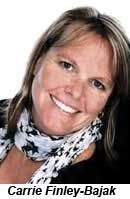 Travel agents who are using Pinterest for social media marketing can feel bullish about the service for the near future.
Travel agents who are using Pinterest for social media marketing can feel bullish about the service for the near future.
Since Pinterest emerged, it quickly became one of the fastest-growing social networking sites of all time. The Wall Street Journal reported that Pinterest raised a $200 million investment earlier this month and that the site is now valued at $5 billion, making it one of the most valuable venture-capital-backed startups in the world.
Pinterest has amassed more than 30 billion pins since launching a couple years ago. According to a New York magazine online article, half of the 30 billion pins have been added in the last six months.
For those not familiar with Pinterest, it's a social site where people collect, organize and share images of items they like. The name Pinterest is a blend of "pin" and "interest." By design, the service is built around the concept of connecting users through things they find inspiring.
For retailers who are using Pinterest to inspire an appetite for travel, it can translate into leads and search engine optimization. What follows are a few insights into how to attract followers on Pinterest and examples of what some travel brands are doing to capture audience share and to build engagement.
Behavior research results
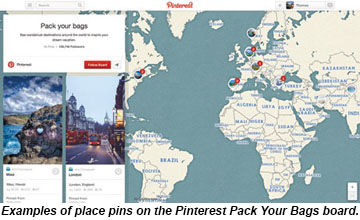 Researchers at the University of Minnesota recently published a report about what attracts attention on Pinterest in terms of reaching followers and getting content re-posted.
Researchers at the University of Minnesota recently published a report about what attracts attention on Pinterest in terms of reaching followers and getting content re-posted.
The report mentioned that words that suggest consumption or desire words -- e.g., "use," "look," "want" and "need" -- performed well on Pinterest. In addition, they found that the top three categories on the service were food and drink; do-it-yourself advice; and crafts and home decor.
Surprisingly, the travel category ranked 15th, while weddings ranked sixth overall out of the 33 predefined Pinterest pinboard categories.
The takeaway for travel consultants is to experiment with pin categories to maximize exposure. For example, posting a photo of a signature food dish from a specialty restaurant on a cruise ship or at a resort might be better classified on a food-and-drink board instead of travel.
Since Pinterest is created on the principle that it is a site for collecting things that people want (or aspire to get), the goal is to provide inspiring imagery that motivates pinners to find out more. Travel consultants are finding success using Pinterest to motivate leads to come to their websites, where they will find a unique call to action.
Whenever users pin, repin, comment or like images on Pinterest, it drives traffic to the retailer's website (assuming that the image was pinned from the website).
Tip: If uploading photos directly to Pinterest, make sure to edit the pin and change the source link to your website. This is the workaround for those who don't have the ability to upload images onto their company website.
Tip: Make sure that pin boards have keyword-rich titles, pins and descriptions that people will organically "search" for on Pinterest.
New ways to reach pinners: Rich Pins
Pinterest is continually rolling out new features to enhance the user experience. One recently introduced feature, called Rich Pins, is worth considering for marketing purposes.
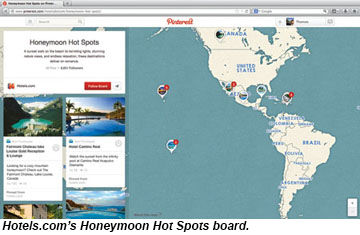 Pinterest describes Rich Pins as pins that include extra information. Currently, there are five types of Rich Pins: movie, recipe, article, product and place.
Pinterest describes Rich Pins as pins that include extra information. Currently, there are five types of Rich Pins: movie, recipe, article, product and place.
Of the Rich Pin types, the one travel consultants could get the most traction from is place.
Pinterest created the place pin because the service noticed that pinners were creating a large number of boards around the vacations they were planning, places near their homes and sites they wanted to see someday.
Place pins enable users to add extra details about an image, such as an address and phone number. The data for the place is powered by Foursquare, an app that enables users to "check in" at places.
Have a look at the Pinterest Pack Your Bags place pin board for inspiration.
There are two ways travel consultants can use place pins. The first is to create a place pin to highlight their local travel agency; the second is to create minimarketing brochures of places.
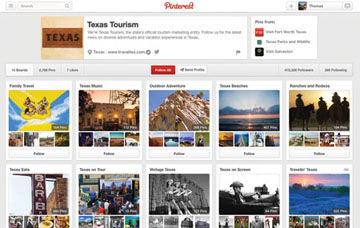 Hotels.com has done a great job using place pins. Check out its Honeymoon Hot Spots board to find a creative way to promote places on a map.
Hotels.com has done a great job using place pins. Check out its Honeymoon Hot Spots board to find a creative way to promote places on a map.
To learn about the other Rich Pins, check out business.pinterest.com.
Best in show
Many travel brands, destination marketing organizations (DMO), resorts, hotels, cruise lines, airlines, travel media and travel consultants are already doing a great job using Pinterest. Here are a few Pinterest best practices I've run across and ideas about what travel brands are doing.
• Be diverse, and let your boards tell a story: The Texas Tourism Pinterest account has 472,358 followers. Part of the reason for this large number of followers, and thus part of the reason it is so successful, could be this DMO's choice of images and diverse topics; its boards help capture the branding and essence of a state that is highly varied in terms of history, geology, geography and environment.
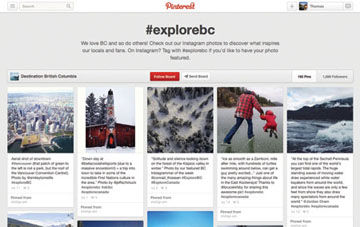 • Cross-promote, crowd-source and use hashtags:Destination British Columbia is a good example of how to use hashtags, Instagram and crowd-sourcing. This DMO created a hashtag to collect images of British Columbia using #explorebc. The hashtag is promoted on Instagram, and fans are encouraged to share photos that inspire fans. Then, the best photos are selected and placed on a Pinterest board.
• Cross-promote, crowd-source and use hashtags:Destination British Columbia is a good example of how to use hashtags, Instagram and crowd-sourcing. This DMO created a hashtag to collect images of British Columbia using #explorebc. The hashtag is promoted on Instagram, and fans are encouraged to share photos that inspire fans. Then, the best photos are selected and placed on a Pinterest board.
• Featured pinner: A good way to promote engagement and to reward followers is to create a featured-pinner Pinterest board. Travel consultants can create a group board and invite one or many people to post pins on the board. (I was selected as a featured pinner on a shared board created by MSC Cruises, which enabled me to leverage photos from a cruise on the MSC Divina. The benefits to me were an increase in exposure and a boost in traffic to my site.)
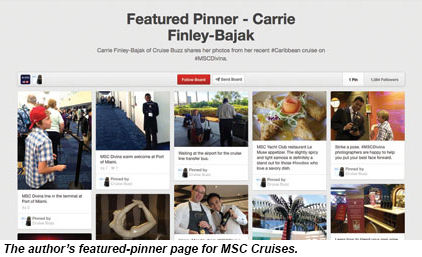 • Contest time: Sponsor a contest and, if possible, get supplier co-op funds to help pay for a prize. Create a "best of" or "caption that" contest to bring attention to your business and advertise it on Pinterest. With that said, the "Pin It to Win It" contests are less popular these days due to Pinterest's branding guidelines. Even so, search "travel contest" on Pinterest to see some examples of how other people are driving traffic back to their websites using contests.
• Contest time: Sponsor a contest and, if possible, get supplier co-op funds to help pay for a prize. Create a "best of" or "caption that" contest to bring attention to your business and advertise it on Pinterest. With that said, the "Pin It to Win It" contests are less popular these days due to Pinterest's branding guidelines. Even so, search "travel contest" on Pinterest to see some examples of how other people are driving traffic back to their websites using contests.
• Tracking results: To keep track of pins and referral traffic, make sure to set up a Pinterest business account. In addition, make sure your business account has a verified website to take advantage of Pinterest's analytics. With these tools it is possible to measure pins, repins, impressions and clicks on a Pinterest page.
Analytics enable marketers to see how well their website is doing, including stats about traffic, popular pins that are getting added and a summary of which pins are getting the most repins.
Pinterest offers information about site analytics at http://business.pinterest.com/en/analytics.
Carrie Finley-Bajak is a social media consultant who specializes in building travel industry branding online.